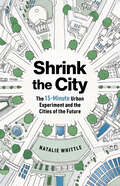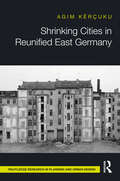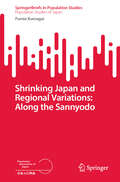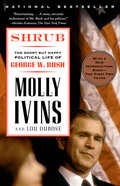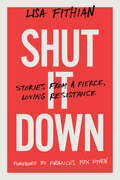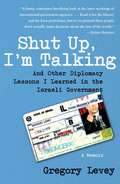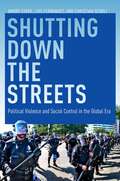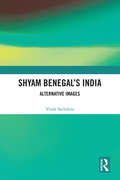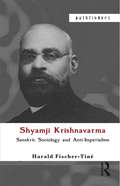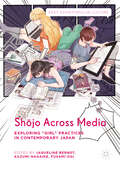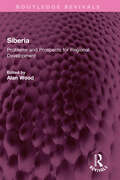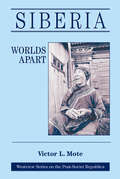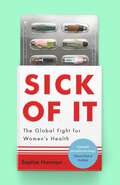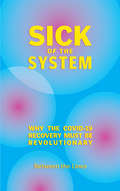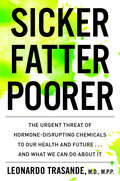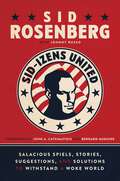- Table View
- List View
Shrewd Samaritan: Faith, Economics, and the Road to Loving Our Global Neighbor
by Bruce WydickLearn to live the message of the Good Samaritan and make a global impact, using the resources already at your disposal.If there were a popularity contest among all the parables of Jesus, the Good Samaritan would probably win. Nobody is against the Good Samaritan because being against the Good Samaritan is like being against Mother Theresa or Oskar Schindler or the firefighters who ran into the World Trade Center. In that same popularity contest, the Shrewd Manager would probably finish last. The Shrewd Manager is lazy, deceitful, and double-crossing. Yet in this alluringly freakish parable, Jesus actually holds up the Shrewd Manager as an example, as he does with the Good Samaritan.This book is about learning to live the message of the Good Samaritan in the context of the globalized world of the twenty-first century. This means learning to love our global neighbor wisely by harnessing the resources at our disposal—our time, talents, opportunities, and money—on behalf of those who are victims of injustice, disease, violence, and poverty.The early disciples were pretty clueless about worldly resources such as time, talent, and money—and unfortunately today we still don’t really get it. There are too many kind, well-intentioned twenty-first-century people with indisputably good intentions but whose impact on the needy is hampered by their inability to diagnose problems properly, harness the resources available to them to solve the right problems, and understand cause-and-effect relationships.Shrewd Samaritan will help develop a framework to better love and care for our neighbors in an age of globalization, when the people in our neighborhoods, or at least those in our potential sphere of influence, has expanded dramatically. Increasingly it will become our global neighbor who takes us out of our comfort zone and challenges us with the needs of a broken world.
Shrink the City: The 15-Minute Urban Experiment and the Cities of the Future
by Natalie Whittle“[Shrink the City] surveys ways in which cities around the globe have created compact neighborhoods where residents’ daily needs are quickly accessible on foot or by bicycle—a concept known as the 15-minute city. . . . deeply researched and winsomely written. . . an invaluable overview of the cutting edge of urban planning.”—Publishers Weekly Cities define the lives of all those who call them home: where we go, how we get there, how we spend our time. But what if we rethink the ways we plan, live in, and move around our cities? What if we didn’t need a car to reach the grocery store? What if we could get back the time we would have spent commuting and put it to other uses? In this fascinating, carefully researched and reported book, longtime Financial Times journalist Natalie Whittle investigates the 15-minute city idea—its pros, cons, and its potential to revolutionize modern living. From Paris, Melbourne, and Rotterdam to Charlotte, North Carolina, and Tempe, Arizona, cities worldwide are being guided by the 15-minute city’s ideals—with varying results. By looking at these examples, Whittle considers: what really happens when a city expands bike lanes and pedestrian areas—and disincentivizes long commutes which approaches to building affordable housing are actually effective how neighborhoods of varying wealth are affected by 15-minute city policies whether it’s possible to convince car-owning city dwellers to replace their vehicles with other forms of transport. This timely book serves as a call to reflect on our cities and neighborhoods—and it outfits us with insights on how to make them more sustainable, safe, and welcoming.
Shrinking Cities in Reunified East Germany
by Agim KërçukuThe book explores the relationship between the shrinking process and architecture and urban design practices. Starting from a journey in former East Germany, six different scenes are explored in which plans, projects, and policies have dealt with shrinkage since the 1990s. The book is a sequence of scenes that reveals the main characteristics, dynamics, narratives, reasons and ambiguities of the shrinking cities’ transformations in the face of a long transition. The first scene concerns the demolition and transformation of social mass housing in Leinefelde-Worbis. The second scene deals with the temporary appropriation of abandoned buildings in Halle-Neustadt. The third scene, observed in Leipzig, shows the results of green space projects in urban voids. The scene of the fourth situation observes the extraordinary efforts to renaturise a mining territory in the Lausitz region. The fifth scene takes us to Hoyerswerda, where emigration and ageing process required a reduction and demolition in housing stock and social infrastructures. The border city of Görlitz, the sixth and last scene, deals with the repopulation policies that aim to attract retirees from the West.
Shrinking Japan and Regional Variations: Along the Hokurikudo and the Tosando I (SpringerBriefs in Population Studies)
by Fumie KumagaiThis book provides an insightful sociological study of the shrinking Japanese population through a regional variation perspective as it varies significantly by municipality, even within the same prefecture. Using demographic data on municipal levels, the book identifies the power unique to each municipality, which can mobilize a shrinking but sustainable Japan. The study identifies the principal explanatory factors based on the small area data of e-Stat through GPS statistical software tools such as G-census and EvaCva within a historical perspective. The theoretical framework of this study, i.e., the reason for regional variations in Japan, is the Goki-Shichido (Five Home Provinces and Seven Circuits of Ancient Japan). This historical knowledge helps in understanding the significance of the regional cultural heritage that remains in each municipality today. The book pays special attention to municipal variations within the same prefecture, utilizing a completely unique approach, unlike those that have been pursued by other researchers. This volume studies two present-day prefectures for detailed analyses based on the Goki-Shichido framework for impacts of regional variations of population decline in Japan. They are Niigata Prefecture, made up of the formerly named Echigo and Sado provinces; Ishikawa Prefecture, formed by the ancient Kaga and Noto provinces; Fukui Prefecture, based on the earlier Wakasa and Echizen provinces of the Hokurikudo; Nagano Prefecture, still called Shinano Province today and commonly divided into four areas and ten regions; and Gifu Prefecture, composed of the ancient Mino and Hida provinces of the Tosando as examples of the impact of municipal power on regional variations of shrinking Japan. However, due to the limitation of the number of pages set forth for Springer Briefs in Population Studies: Population Studies of Japan, for which the current publication is a part, it has become necessary to divide the book into two volumes, namely Volume I and Volume II. Because of this limitation the current volume I is consisted of three chapters, namely, Chapter 1: Issues, theoretical framework, and methodology; Chapter 2: Niigata Prefecture in the Hokurikudo; and Chapter 3: Ishikawa Prefecture in the Hokurikudo. The remaining three prefectures, i.e., Fukui in the Hokurikudo area, Nagano and Gifu both in the Tosando area will be discussed in the Volume II of this book. By presenting unique analyses of regional variations on small municipal levels, with demographic variables, social indicators, and historical identities, this book offers suggestions for effective regional policies to revitalize a shrinking Japan to a sustainable one. The Volume I, therefore, analyzes and discusses in detail both Niigata and Ishikawa prefectures of the Hokurikudo.
Shrinking Japan and Regional Variations: Along the Hokurikudo and the Tosando II (SpringerBriefs in Population Studies)
by Fumie KumagaiThis book provides an insightful sociological study of the shrinking Japanese population through a regional variation perspective as it varies significantly by municipality, even within the same prefecture. Using demographic data on municipal levels, the book identifies the power unique to each municipality, which can mobilize a shrinking but sustainable Japan. The study identifies the principal explanatory factors based on the small area data of e-Stat through GPS statistical software tools such as G-census and EvaCva within a historical perspective. The theoretical framework of this study, i.e., the reason for regional variations in Japan, is the Goki-Shichido (Five Home Provinces and Seven Circuits of Ancient Japan). This historical knowledge helps in understanding the significance of the regional cultural heritage that remains in each municipality today. The book pays special attention to municipal variations within the same prefecture, utilizing a completely unique approach, unlike those that have been pursued by other researchers. This book studies three present-day prefectures for detailed analyses based on the Goki-Shichido framework for impacts of regional variations of population decline in Japan. They are Niigata Prefecture, made up of the formerly named Echigo and Sado provinces; Ishikawa Prefecture, formed by the ancient Kaga and Noto provinces; Fukui Prefecture, based on the earlier Wakasa and Echizen provinces of the Hokurikudo; Nagano Prefecture, still called Shinano province today and commonly divided into four areas and ten regions; and Gifu Prefecture, composed of the ancient Mino and Hida provinces of the Tosando as examples of the impact of municipal power on regional variations of shrinking Japan. However, due to the limitation of the number of pages set forth for Springer Briefs in Population Studies: Population Studies of Japan, for which the current publication is a part, it has become necessary to divide the book into two volumes, namely Volume I and Volume II. Because of this limitation, the current Volume II consisted of four chapters. They are Chapter 1: Fukui Prefecture in the Hokurikudo; Chapter 2: Nagano Prefecture in the Tosando; Chapter 3: Gifu Prefecture in the Tosando, and Chapter 4: Epilogue: The Future of Shrinking Japan. The remaining two prefectures, i.e., Niigata and Ishikawa prefectures in the Hokurikudo area have been discussed in the Volume I of this book. By presenting unique analyses of regional variations on small municipal levels, with demographic variables, social indicators, and historical identities, this book offers suggestions for effective regional policies to revitalize a shrinking Japan to a sustainable one.
Shrinking Japan and Regional Variations: Along the Sannyodo (SpringerBriefs in Population Studies)
by Fumie KumagaiTaking the Goki-Shichido (Five Home Provinces and Seven Circuits of Ancient Japan) as a theoretical framework, this book examines shrinking Japan from a regional variation perspective by municipality along the ancient Sannyodo, which comprises eight provinces and four prefectures today. The book identifies the principal explanatory factors based on the small area data of e-Stat through GPS statistical software tools such as G-census and EvaCva, within a historical perspective. This historical knowledge helps in understanding the significance of the regional cultural heritage that remains in each municipality today. The book pays special attention to municipal variations within the same prefecture, presenting a completely unique approach from what other researchers have pursued.This book studies two present-day prefectures along the ancient Sannyodo for detailed analyses of the impacts of regional variations of population decline in Japan. They are Hiroshima Prefecture, made up of the former Bingo and Aki provinces, and Yamaguchi Prefecture, formed by the ancient provinces of Suo and Nagato. The reasons for selecting these two prefectures of ancient Sannyodo are twofold. First, they are made up of a multiple number of the ancient provinces. Second, other prefectures that fall under the Sannyodo have been studied in the previous works of the present author by adopting the same methods of analyses. Thus, by presenting unique analyses of regional variations on small municipal levels in Hiroshima and Yamaguchi prefectures along the Sannyodo, this book offers suggestions for effective regional policy to revitalize shrinking Japan to a sustainable one.
Shrub: The Short but Happy Political Life of George W. Bush
by Molly Ivins Lou DuboseWhen it comes to reporting on politics, nobody does it smarter or funnier than bestselling author Molly Ivins. In Shrub, Ivins focuses her Texas-size smarts on the biggest politician in her home state: George Walker Bush, or "Shrub," as Ivins has nicknamed Bush the Younger. A candidate of vague speeches and an ambiguous platform, Bush leads the pack of GOP 2000 presidential hopefuls; "Dubya" could very well be our next president. What voters need now is an original, smart, and accessible analysis of Bush--one that leaves the "youthful indiscretions" to the tabloids and gets to the heart of his policies and motivations. Ivins is the perfect woman for the job. With her trademark wit and down-home wisdom, Molly Ivins shares three pieces of advice on judging a politician: "The first is to look at the record. The second is to look at the record. And third, look at the record. " In this book, Ivins takes a good, hard look at the record of the man who could be the leader of the free world. Beginning with his post-college military career, Ivins tracks Dubya's winding, sometimes unlikely path from a failed congressional bid to a two-term governorship. Bush has made plenty of friends and supporters along the way, including Texas oil barons, evangelist Billy Graham, and co-investors in the Texas Rangers baseball team. "You would have to work at it to dislike the man," she writes. But for all of Bush's likeability, Ivins points to a disconcerting lack of political passion from this ascending presidential candidate. In her words, "If you think his daddy had trouble with 'the vision thing,' wait till you meet this one. " Witty, trenchant, and on target, Ivins gives a singularly perceptive and entertaining analysis of George W. Bush. To head to the voting booth without it would be downright un-American. From Shrub: The Short but Happy Political Life of George W. Bush " The past is prologue in politics. If a politician is left, right, weak, strong, given to the waffle or the flip-flop, or, as sometimes happens, an able soul who performs well under pressure, all that will be in the record. " ¸ Bush's welfare record:"Texas pols like to 'git tuff' on crime, welfare, commies, and other bad stuff. Bush proposed to git tuff on welfare recipients by ending the allowance for each additional child--which in Texas is $38 a month. " ¸ Bush and the Christian right:"Bush has learned to dance with the Christian right. It has been interesting and amusing to watch the process. Interesting because it's sometimes hard to tell who's leading and who's following; amusing because when a scion of Old Yankee money gets together with a televangelist with too much Elvis, the result is swell entertainment. " ¸ Bush's environmental record:Since Governor Bush's election, Texas air quality has been rated the worst in the nation, leading all fifty states in overall toxic releases, recognized carcinogens in the air, cancer risk, and ten other categories of pollutants. ¸ Bush's military career:"Bush was promoted as the Texas Air National Guard's an
Shut It Down: Stories from a Fierce, Loving Resistance
by Lisa FithianA veteran activist's guide to direct action and strategic civil disobedience as the most radical and rapid means to social changeFor decades, Lisa Fithian&’s work as an advocate for civil disobedience and nonviolent direct action has put her on the frontlines of change. Described by Mother Jones as &“the nation&’s best-known protest consultant,&” Fithian has supported countless movements including the Battle of Seattle in 1999, rebuilding and defending communities following Hurricane Katrina, Occupy Wall Street, and the uprisings at Standing Rock and in Ferguson. For anyone who wants to become more active in resistance or is just feeling overwhelmed or hopeless, Shut It Down offers strategies and actions you can take right now to promote justice and incite change in your own community.In Shut It Down Fithian shares historic, behind-the-scenes stories from some of the most important people-powered movements of the past several decades. She shows how movements that embrace direct action have always been, and continue to be, the most radical and rapid means for transforming the ills of our society. Shut It Down is filled with instructions and inspiration for how movements can evolve as the struggle for social justice continues in the Trump era and beyond.While recognizing that electoral politics, legislation, and policy are all important pathways to change, Shut It Down argues that civil disobedience is not just one of the only actions that remains when all else fails, but a spiritual pursuit that protects our deepest selves and allows us to reclaim our humanity. Change can come, but only if we&’re open to creatively, lovingly, and strategically standing up, sometimes at great risk to ourselves, to protect what we love.
Shut Up & Sing: How Elites from Hollywood, Politics, and the Media are Subverting America
by Laura IngrahamShut Up & Sing: How Elites from Hollywood, Politics, and the UN are Subverting America by Laura Ingraham
Shut Up and Sing: How Elites from Hollywood, Politics, and the UN are Subverting America
by Laura IngrahamIngraham unmasks the shallowness of elite thinking everywhere it is found: in politics, the media, the ivory tower, arts and entertainment, business and international organizations.
Shut Up, I’m Talking: And Other Diplomacy Lessons I Learned in the Israeli Government--a Memoir
by Gregory LeveyShut Up, I'm Talking is a smart, hilarious insider take on Israeli politics that reads like the bastard child of Thomas Friedman and David Sedaris. Now a political writer for Salon, Gregory Levey stumbled into a job as speechwriter for the Israeli delegation to the United Nations at age twenty-five and suddenly found himself, like a latter-day Zelig, in the company of foreign ministers, U.S. senators, and heads of state. Much to his surprise, he was soon attending U.N. sessions and drafting official government statements. The situation got stranger still when he was transferred to Jerusalem to write speeches for Prime Minister Ariel Sharon. Shut Up, I'm Talking is a startling account of Levey's journey into the nerve center of Middle Eastern politics at one of the most turbulent times in Israeli history. During his three years in the Israeli government, the Second Intifada continued on in fits and starts, Yasser Arafat died, Hamas came to power, and Ariel Sharon fell into a coma. Levey was repeatedly thrust into highly improbable situations -- from being the sole "Israeli" delegate (even though he's Canadian) at the U.N. General Assembly, with no idea how "his" country wanted to vote; to nearly inciting an international incident with his high school French translation of an Arab diplomat's anti-Israel remarks; to communicating with Israeli intelligence about the suspected perpetrators of suicide bombings; to being offered leftover salami from Ariel Sharon's lunch. As Levey got better acquainted with the personalities in the government's inner sanctum, he witnessed firsthand the improvisational and ridiculously casual nature of the country's behind-the-scenes leadership -- and realized that he wasn't the only one faking his way through politics. With sharp insight and great appreciation for the absurd, Levey offers the first-ever look inside Israel's politics from the perspective of a complete outsider, ultimately concluding that the Israeli government is no place for a nice Jewish boy.
Shutting Down the Streets: Political Violence and Social Control in the Global Era
by Luis A. Fernandez Amory Starr Christian SchollRecently, a wall was built in eastern Germany. Made of steel and cement blocks, topped with razor barbed wire, and reinforced with video monitors and movement sensors, this wall was not put up to protect a prison or a military base, but rather to guard a three-day meeting of the finance ministers of the Group of Eight (G8). The wall manifested a level of security that is increasingly commonplace at meetings regarding the global economy. The authors of Shutting Down the Streets have directly observed and participated in more than 20 mass actions against global in North America and Europe, beginning with the watershed 1999 WTO meetings in Seattle and including the 2007 G8 protests in Heiligendamm. Shutting Down the Streets is the first book to conceptualize the social control of dissent in the era of alterglobalization. Based on direct observation of more than 20 global summits, the book demonstrates that social control is not only global, but also preemptive, and that it relegates dissent to the realm of criminality. The charge is insurrection, but the accused have no weapons. The authors document in detail how social control forecloses the spaces through which social movements nurture the development of dissent and effect disruptive challenges.
Shyam Benegal’s India: Alternative Images
by Vivek SachdevaThis book examines Shyam Benegal’s films and alternative image(s) of India in his cinema, and traces the trajectory of changing aesthetics of his cinema in the post-liberalisation era. The book engages with the challenges faced by India as a nation-state in post-colonial times. Looking at hybrid and complex narratives of films like Manthan, Junoon, Kalyug, Charandas Chor, Sooraj Ka Satvaan Ghoda, Zubeidaa and Well Done Abba , among others, it analyses how these stories and characters, adapted and derived from mythology, folk-tales, historical fiction and novels, are rooted in the socio-political contexts of modern India. The author explores diverse themes in Benegal’s cinema such as the loss of home and identity, women’s sexuality, and the status of dalits and Muslims in India. He also focuses on how the filmmaker expertly weaves history with myth, culture, and contemporary politics and discusses the debate around the interpretive value of film adaptations, adaptation of history and the representations of marginalised communities and liminal spaces. The book will be useful for students and researchers of film studies, cultural studies, and the humanities. It will also interest readers of Indian cinema and the social and cultural history of India.
Shyamji Krishnavarma: Sanskrit, Sociology and Anti-Imperialism (Pathfinders)
by Harald Fischer-TineThis book is the first critical biography on Shyamji Krishnavarma — scholar, journalist and national revolutionary who lived in exile outside India from 1897 to 1930. His ideas were crucial in the creation of an extremist wing of anti-imperial nationalism. The work delves into a fascinating range of issues such as colonialism and knowledge, political violence, cosmopolitanism, and diaspora. Lucidly written, and with an insightful analysis of Krishnavarma’s life and times, this will greatly interest scholars and researchers of modern Indian history, politics, the nationalist movement, as well as the informed lay reader.
Shōjo Across Media: Exploring "Girl" Practices in Contemporary Japan (East Asian Popular Culture)
by Jaqueline Berndt Kazumi Nagaike Fusami OgiSince the 2000s, the Japanese word shōjo has gained global currency, accompanying the transcultural spread of other popular Japanese media such as manga and anime. The term refers to both a character type specifically, as well as commercial genres marketed to female audiences more generally. Through its diverse chapters this edited collection introduces the two main currents of shōjo research: on the one hand, historical investigations of Japan’s modern girl culture and its representations, informed by Japanese-studies and gender-studies concerns; on the other hand, explorations of the transcultural performativity of shōjo as a crafted concept and affect-prone code, shaped by media studies, genre theory, and fan-culture research. While acknowledging that shōjo has mediated multiple discourses throughout the twentieth century—discourses on Japan and its modernity, consumption and consumerism, non-hegemonic gender, and also technology—this volume shifts the focus to shōjo mediations, stretching from media by and for actual girls, to shōjo as media. As a result, the Japan-derived concept, while still situated, begins to offer possibilities for broader conceptualizations of girlness within the contemporary global digital mediascape.
Siberia: Problems and Prospects for Regional Development (Routledge Revivals)
by Alan WoodFirst published in 1987, Siberia examines the developments in the different sectors of Siberian economy and discusses the role of this vast and little-known region in the Soviet Union’s overall economic and defence strategy. It surveys historical developments and the geography of the region and focuses on the key problem areas such as manpower shortage, the difficulties involved in exploiting the territory’s natural resources, internal communications – including the construction of the Baikal-Amur Railway in the Far East- and considers Siberia’s place in the context of international relations and the world economy. This book is a must read for scholars of Russian history, Russian geopolitics, European politics, international relations and European history.
Siberia: Worlds Apart
by Victor L MoteKnown to most as a realm of exile and labor camps, Siberia is also one of the world's wealthiest resource bases. This harsh, vast land constitutes nearly three-quarters of Russia's territory, yet after four centuries of Slavic migration and procreation it is home to a mere 32 million people.In this comprehensive book, Victor Mote illuminates the dichotomy between Siberia's rich treasurehouse of resources and its peripheral relationship to the rest of the world. With this paradox in mind, he traces the region's history from the Stone Age to the present, emphasizing the unique blend of wit and will developed by inhabitants to survive one of the most brutal environments in the world?a land that has been part colony, part prison, and part frontier. Mote also explores the geography, ethnography, economics, and politics of Siberia and its people, providing a multidisciplinary perspective for scholars and general readers alike interested in Eurasia's ?forgotten quarter.?
Sicherheit versus Freiheit
by Rüdiger VoigtFreiheit und Sicherheit scheinen Gegensätze und deshalb unvereinbar zu sein: Für jedes Stück Sicherheit verlieren wir ein Stück Freiheit. Dieser Grundwiderspruch bildet den Ausgangspunkt und das Thema dieses Bandes.
Sicherheits- und verteidigungspolitische Neujustierungen: Friedensethik nach der Zeitenwende • Band 1 (Gerechter Frieden)
by Ines-Jacqueline Werkner Anna LöwMit dem russischen Angriffskrieg gegen die Ukraine haben sich die sicherheits- und verteidigungspolitischen Konstellationen fundamental verändert – nicht nur in Deutschland, sondern in ganz Europa. Vor diesem Hintergrund diskutieren die Autorinnen und Autoren des Bandes die Neujustierungen in der deutschen Sicherheits- und Verteidigungspolitik. Dabei stehen zum einen die beiden zentralen Dokumente – die Nationale Sicherheitsstrategie und die neuen Verteidigungspolitischen Richtlinien – im Fokus der Betrachtung. Zum anderen richtet sich der Blick auf die Folgen der US-amerikanischen Wahl im November 2024 für die Sicherheit und Verteidigungsfähigkeit Deutschlands und Europas. Das schließt auch Fragen der nuklearen Abschreckung mit ein.
Sicily's Queens 1061-1266: The Countesses and Queens of the Norman-Swabian Era (Sicilian Medieval Studies)
by Jacqueline AlioEighteen women. Eighteen stories. Each one unique. Some never told before.They are the semi-forgotten women of European medieval history. This is the first compendium of scholarly biographies of the countesses and queens of the Kingdom of Sicily during the Hauteville and Hohenstaufen reigns, based on original research in medieval charters, chronicles and letters, augmented by extensive on-site research at castles, cathedrals and towns across Europe.This abridged edition of the author's Queens of Sicily 1061-1266 brings to the reader the entire narrative text of that 740-page print book published in 2019, with a bibliography, timeline, 26 genealogical tables, 15 maps, several photographs of things like pages from medieval manuscripts and places mentioned in the text, and 5 appendices. It does not include the 700 endnotes. The bibliography lists original (medieval) sources to support the facts presented in the text but not the hundreds of secondary works (such as articles) listed in the print edition.The result of years of research in several countries, Queens of Sicily 1061-1266 was the first collection of biographies of these women ever published in any language in a single publication. Until it arrived in 2019, anybody seeking information about all of these women had to consult various sources.The biographies follow a lengthy introduction and a brief survey of Sicilian history. Each chapter is dedicated to a countess or queen: Judith of Evreux, Eremburga of Mortain, Adelaide del Vasto, Elvira of Castile, Sibylla of Burgundy, Beatrice of Rethel, Margaret of Navarre, Joanna of England, Sibylla of Acerra, Irene of Constantinople, Constance of Sicily, Constance of Aragon, Yolanda of Jerusalem, Isabella of England, Bianca Lancia, Elisabeth of Bavaria, Beatrice of Savoy, Helena of Epirus.This book is about the lives of medieval women, but to place the Kingdom of Sicily, which survived for seven centuries, into a wider historical context an appendix profiles the last queen, Maria Sophia of Bavaria, who lived until 1925, with a previously-unpublished interview of a niece who knew her. Maria Sophia was born into the same dynasty as Elisabeth of Bavaria, who became Queen of Sicily in 1250.Another appendix includes the author's translation (from the original Medieval Sicilian) of the Contrasto of Cielo of Alcamo, the longest poem of the Sicilian School that flourished under Frederick II. It is possible that one or two of these queens heard this poem recited or sung at court. Other appendices focus on the only crown of a Sicilian queen to survive from this era (worn by Constance of Aragon and shown on the book's cover), a gold pendant worn by Queen Margaret given to her by Henry II of England and Eleanor of Aquitaine, and the ceremonial rite of coronation known to some of these queens.This book is very complete and its publication was long overdue. Some of these women's stories are exciting, even inspiring. They show these countesses and queens as wives, mothers, leaders, soldiers, crusaders and administrators. These women were anything but weak or docile. Judith withstood a winter siege in a makeshift fort and then led a company of knights to occupy a town in the rugged Sicilian mountains. As regent for her young son, Margaret was the most powerful woman in Europe and the Mediterranean, governing a kingdom of some two million subjects while facing the incessant insurrections instigated by unruly barons and conniving clergy. She sometimes jailed enemies without so much as a second thought. Joanna went on crusade with her brother, Richard Lionheart, whose death in France she later avenged by having his killer tortured to death. Constance of Sicily commanded troops in a campaign to take back the crown usurped by a zealous kinsman.Not only is this work highly detailed and useful as a reference, it's very readable, without the verbose academese of many books of this kind (most of its academic jargon was re
Sick of It: The Global Fight for Women's Health - 'Powerful and inspiring' Elinor Cleghorn, author of Unwell Women
by Sophie HarmanA powerful call to confront the reasons why politics is jeopardising women's health across the world, by a prize-winning academic'A powerful and inspiring must-read' Elinor Cleghorn, author of Unwell Women'Radical and thought-provoking, this book should drive us all to action - and the author tells us how' Gina Rippon, author of The Gendered BrainWe know the causes of disease and death among women all over the world. We have the funding from governments and philanthropists to tackle them. So why are women still dying when they don't have to? Across the globe, women's health is being caught in the crossfire of politics: from the repeal of abortion rights and the bombing of Ukrainian maternity hospitals, to lesser-known issues like healthwashing and the exploitation of vulnerable patients as well as women health workers.Exploring urgent questions including populism, big data and the undervaluing of women's work, Sick of It also offers smart solutions on how to fix this crisis through activism and political work.'A very powerful read' Lucy Easthope, author of When The Dust Settles'Illuminating, accessible and important' Dr Rageshri Dhairyawan, author of Unheard: The Medical Practice of Silencing'Sophie Harman has gathered both the disturbing and heartbreaking facts and the vital possibilities open to all of us for action and engagement' Stella Duffy, OBE
Sick of It: The Global Fight for Women's Health - 'Powerful and inspiring' Elinor Cleghorn, author of Unwell Women
by Sophie HarmanA powerful call to confront the reasons why politics is jeopardising women's health across the world, by a prize-winning academic'A powerful and inspiring must-read' Elinor Cleghorn, author of Unwell Women'Radical and thought-provoking, this book should drive us all to action - and the author tells us how' Gina Rippon, author of The Gendered BrainWe know the causes of disease and death among women all over the world. We have the funding from governments and philanthropists to tackle them. So why are women still dying when they don't have to? Across the globe, women's health is being caught in the crossfire of politics: from the repeal of abortion rights and the bombing of Ukrainian maternity hospitals, to lesser-known issues like healthwashing and the exploitation of vulnerable patients as well as women health workers.Exploring urgent questions including populism, big data and the undervaluing of women's work, Sick of It also offers smart solutions on how to fix this crisis through activism and political work.'A very powerful read' Lucy Easthope, author of When The Dust Settles'Illuminating, accessible and important' Dr Rageshri Dhairyawan, author of Unheard: The Medical Practice of Silencing'Sophie Harman has gathered both the disturbing and heartbreaking facts and the vital possibilities open to all of us for action and engagement' Stella Duffy, OBE
Sick of the System: Why the COVID-19 Recovery Must Be Revolutionary
by John Clarke Richard Swift Emma Jackson Justin Piché Alberto Toscano Jamie Swift Harry Glasbeek Gary Kinsman Kai Cheng Thom Robyn Maynard Andrew Jackson Anita Girvan James T. Brophy Nicole Marie Burton Dallas Hunt El Jones Margaret M. Keith Julie S. Lalonde Wayne Lewchuk Jane E. McArthur Alexander McClelland Karen Messing Elaine Power Gina Starblanket Hugh D.A. GoldringFamilies left grieving; small businesses shuttered; communities in lockdown; precarious workers set adrift; health care workers stressed beyond endurance. The COVID-19 pandemic has shaken the world to its core. But the cracks already ran deep. Featuring essays on poverty, health care, incarceration, basic income, policing, Indigenous communities, and more, this anthology delivers a stinging rebuke of the pre-pandemic status quo and a stark exposé of the buried weaknesses in our social and political systems. As policy makers scramble to bail out corporations and preserve an unsustainable labour market, an even greater global catastrophe – in the form of ecological collapse, economic recession, and runaway inequality – looms large on the horizon. What can we do? From professors to poets, the authors of Sick of the System speak in one voice: We can turn our backs on “normal.” We can demand divestment, redistribution, and mutual aid. We can seize new forms of solidarity with both hands. As the world holds its breath, revolutionary ideas have an unprecedented chance to gain ground. There should be no going back.
Sicker, Fatter, Poorer: The Urgent Threat of Hormone-Disrupting Chemicals to Our Health and Future . . . and What We Can Do About It
by Leonardo TrasandeA leading voice in public health policy and top environmental medicine scientist reveals the alarming truth about how hormone-disrupting chemicals are affecting our daily lives—and what we can do to protect ourselves and fight back. Lurking in our homes, hiding in our offices, and polluting the air we breathe is something sinister. Something we’ve turned a blind eye to for far too long. Dr. Leonardo Trasande, a pediatrician, professor, and world-renowned researcher, tells the story of how our everyday surroundings are making us sicker, fatter, and poorer. Dr. Trasande exposes the chemicals that disrupt our hormonal systems and damage our health in irreparable ways. He shows us where these chemicals hide—in our homes, our schools, at work, in our food, and countless other places we can’t control—as well as the workings of policy that protects the continued use of these chemicals in our lives. Drawing on extensive research and expertise, he outlines dramatic studies and emerging evidence about the rapid increases in neurodevelopmental, metabolic, reproductive, and immunological diseases directly related to the hundreds of thousands of chemicals that we are exposed to every day. Unfortunately, nowhere is safe. But, thanks to Dr. Trasande’s work on the topic, and his commitment to effecting change, this book can help. Through a blend of narrative, scientific detective work, and concrete information about the connections between chemicals and disease, he shows us what we can do to protect ourselves and our families in the short-term, and how we can help bring the change we deserve.
Sid-izens United: Salacious Spiels, Stories, Suggestions, and Solutions to Withstand a Woke World
by Sid RosenbergThe legendary radio personality and equal-opportunity offender delivers authentic and unapologetic takes on the state of everything—from politics to sports, and pop culture to fitness—all with his inimitable style and humor. &“Sid Rosenberg writes the way he talks: fast and blunt. His book is entertaining and provides the reader insight into a guy who hit the bottom but pulled himself up to great success. You&’ll get your money&’s worth and more.&” —Bill O&’Reilly, Media GuyPhonies and frauds, beware. Whether you&’re an athlete, entertainer, or politician—Sid Rosenberg leaves nobody unscathed. Sid helps navigate the tough topics of today, clearly laying out his thoughts and opinions in the one-of-a-kind style and charm that has made him one of the top radio and TV talents in the country. He also provides a &“call-to-action&” to the reader with his Sid-izen Solutions at the end of each hot-topic chapter. &“Every person is born with a filter between their brain and their mouth. Sid Rosenberg was born without one. Anything he thinks of he says. Love him or hate him…he&’s the real deal.&” —Chazz Palminteri A must-read for the politically incorrect, Sid-izens United: Salacious Spiels, Stories, Suggestions, and Solutions to Withstand a Woke World captures Sid at his best—showing once again why his radio show reaches millions of devoted Sid-izens each week. &“Sid Rosenberg is New York personified—caustic, unfiltered, hilarious, and with a huge heart. The bad boy of radio dispenses ripping tales about fame, sport, and politics in his new book. But the sweet bonus is the wisdom he learned from the school of hard knocks on how to succeed at marriage and fatherhood.&” —Miranda Devine &“I&’ve known Sid since he was a customer service agent for a company nobody ever heard of. The fact that I would care what he has to say about world politics or society as a whole is as shocking to me as it is to you, but here I am laughing and crying while hearing his unmistakably unique voice in my ears as I turn the pages of this book. Sid&’s a talented creator, an unapologetic and gifted performer in a sea of copycats and unoriginal thoughts. He simply stands out. We share some of the same demons and I&’m beyond proud to see him overcome them and succeed as he has and become the father and man that his dad would be so proud of. I have no idea what a Sid-izen is, and I&’m terrified now that I might be one.&” —Craig Carton

